A captivating mix of black and white fur patterns can make dog breeds stand out from the crowd. These breeds have become beloved family pets and companions, thanks to their unique looks and distinct personalities.
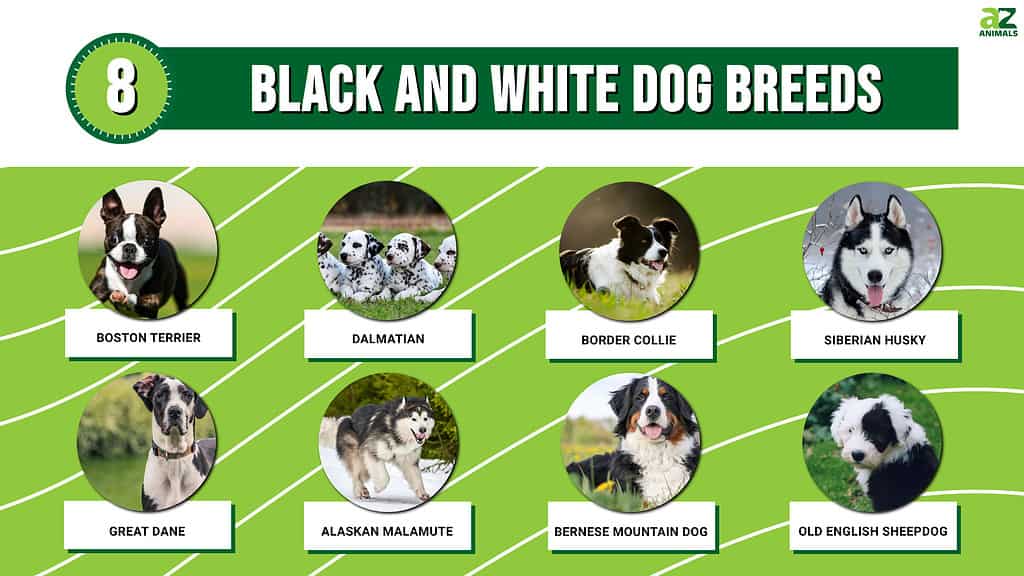
But it’s essential to understand that each breed has its own set of characteristics and requirements, which can differ significantly. In addition to its aesthetic appeal, the color of a dog’s coat is sometimes linked to specific traits or behaviors. While color alone shouldn’t be the sole factor when choosing a canine companion, it can be a helpful starting point.
In this article, we discover eight black and white dog breeds, shedding light on their origins, temperament, grooming, and exercise needs.
1.) Boston Terrier
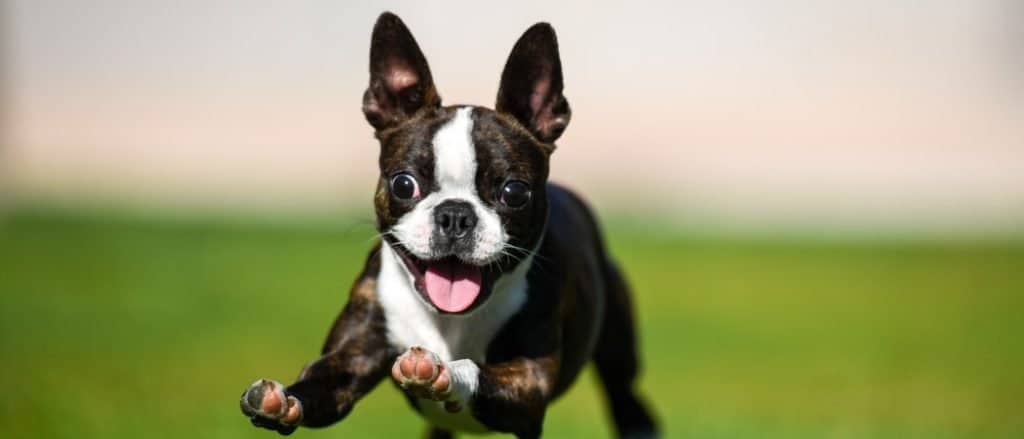
Often referred to as the “American Gentleman,” the Boston terrier is an all-American breed with a history dating back to the late 19th century.
©Zero Degrees Photography/Shutterstock.com
The Boston terrier is a small, energetic breed known for its distinctive “tuxedo” coat and friendly, lively personality. Often referred to as the “American Gentleman,” the Boston terrier is an all-American breed with a history dating back to the late 19th century. This affectionate and adaptable breed is an excellent choice for singles, families, and seniors alike.
Breed Origin
The Boston terrier originated in the U.S., specifically in Boston, Massachusetts, in the late 19th century. The breed was created by crossing the now-extinct white English terrier with English bulldog. The resulting offspring were later bred with French bulldogs, ultimately producing the charming and affectionate breed we know today.
The American Kennel Club (AKC) officially recognized the breed in 1893, and it has since remained a popular companion in the U.S. and beyond.
Personality and Temperament
Boston terriers are friendly, affectionate, and intelligent. They’re highly adaptable and can thrive in various living situations, including apartments. Boston terriers are generally good with children and other pets, making them a great choice for families. They have lively personalities and can be quite entertaining with their playful antics!
Boston terriers are eager to please, which can make training a breeze. They respond well to positive reinforcement and enjoy learning new tricks and commands. Their sociable nature also makes them excellent candidates for therapy or emotional support roles.
2.) Dalmatian
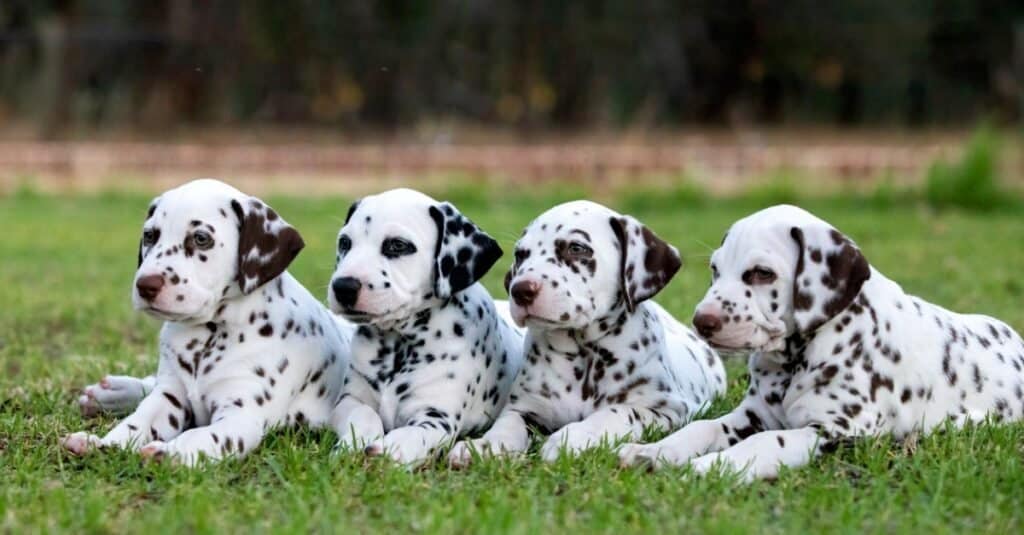
The breed is named after the historical region of Dalmatia, which is located in modern-day Croatia.
©iStock.com/animalinfo
The Dalmatian is a medium-sized, athletic breed known for its striking black or liver-spotted coat and unique history as a coach dog. This energetic and intelligent breed has become a symbol of firehouses and a popular family pet due to its friendly nature and adaptability.
Breed Origin
Historians don’t know the exact origin of the Dalmatian, but these dogs may have ancient roots. Evidence of spotted dogs appears in artwork dating back thousands of years.
The breed is named after the historical region of Dalmatia, which is located in modern-day Croatia, where it’s thought to have been further developed. Dalmatians were initially coach dogs, running alongside horse-drawn carriages to protect them from highwaymen and other threats. They later became associated with firehouses, as they formed strong bonds with horses and could calm them during fires.
Personality and Temperament
Dalmatians are friendly, outgoing, and intelligent. They’re highly energetic and require regular physical activity to stay fit and mentally healthy. Dalmatians are good with children and other pets when properly socialized, making them wonderful pets for families. They’re loyal and protective, with a natural instinct to guard their home and loved ones.
Training and socialization are crucial for Dalmatians, as they can be headstrong and independent at times. Early, consistent training using positive reinforcement techniques will help ensure a well-behaved and well-adjusted companion.
3.) Border Collie

The
border collie
hails from the border region between England and Scotland. The breed’s name derives from this geographical origin.
©LSphotoCZ/Shutterstock.com
The border collie is a medium-sized, highly intelligent breed renowned for its exceptional herding abilities and striking black and white coat. This agile and energetic breed is great for active households and individuals who are willing to dedicate time and effort to keep them physically and mentally stimulated.
Breed Origin
The border collie hails from the border region between England and Scotland. The breed’s name derives from this geographical origin.
Border collies have been bred for their herding skills and intelligence, making them excellent at controlling and maneuvering livestock. Their keen instincts, agility, and tireless work ethic have earned them a reputation as one of the world’s most skilled herding dogs.
Personality and Temperament
Border collies are intelligent, energetic, and loyal. They’re highly trainable and excel in various dog sports and activities, including obedience, agility, and flyball. They form strong bonds with their families and have a natural instinct to protect their loved ones.
But border collies are not a fit for everyone. Their high energy levels and intelligence require regular physical and mental stimulation to prevent boredom and destructive behaviors. They’re best for active households. They need ample space to run and play, and they thrive in the company of an owner who is dedicated to providing structured activities and training.
4.) Siberian Husky
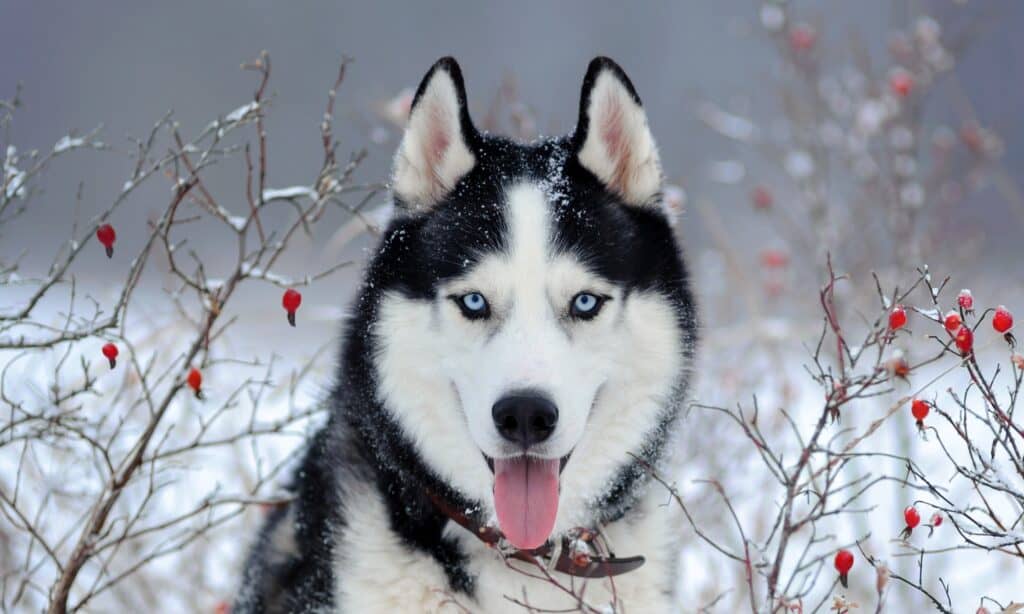
Huskies are intelligent and trainable, but they can also be stubborn and willful at times.
©iStock.com/format35
The Siberian husky is a medium-sized, powerful breed known for its striking blue eyes, thick double coat, and wolf-like appearance. Originally bred for sled-pulling in harsh Arctic conditions, this breed has a rich history. It has become a popular family pet for those who can meet its exercise and grooming needs.
Breed Origin
The Siberian husky originated in Siberia, Russia, where it was bred by the Chukchi people as a sled dog and companion. The breed can withstand the harsh Arctic climate and pull sleds over long distances at moderate speeds. In the early 20th century, sled dog racers brought Siberian huskies to Alaska to participate in races. Here, they gained popularity and recognition for their endurance and agility.
Personality and Temperament
Siberian huskies are friendly, outgoing, and independent. They’re intelligent and trainable, but they can also be stubborn and willful at times. Early ongoing training and socialization are crucial for Siberian huskies to become well-adjusted companions. They have a strong pack mentality and form strong bonds with their families, but they can be aloof with strangers.
Siberian Huskies are an energetic breed that requires regular exercise to thrive. They’re best suited for big, active homes. Their natural athleticism and stamina make them great companions for activities like hiking, jogging, and skijoring.
5.) Great Dane
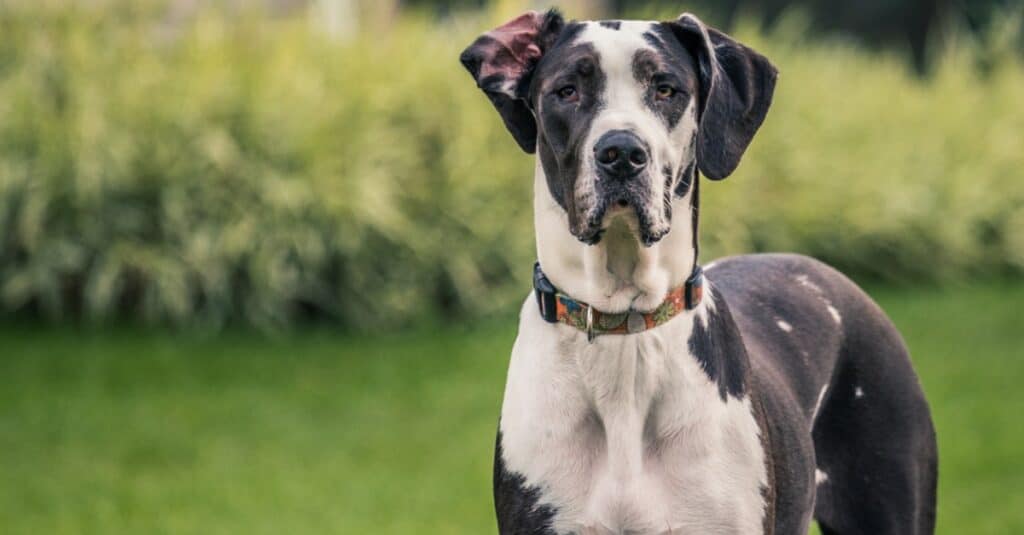
The
great Dane
is believed to have originated in Germany, where it was bred as a hunting and guard dog.
©iStock.com/Earl-Wilkerson
The great Dane is a giant, majestic breed known for its towering stature, elegant appearance, and gentle temperament. Often referred to as the “gentle giant,” this breed has become a popular choice for families seeking a loving and loyal companion.
Breed Origin
The great Dane is believed to have originated in Germany, where it was bred as a hunting and guard dog. The breed’s ancestors are traced back to ancient times. Evidence of similar giant breeds appear in Egyptian, Greek, and Roman art and literature. Over time, the great Dane’s role shifted from a fierce hunter to a more docile companion, and selective breeding helped refine the breed’s appearance and temperament.
Personality and Temperament
Great Danes are gentle, affectionate, and friendly. Despite their imposing size, they’re often “lap dogs” due to their desire for close human contact and affection. They’re intelligent and eager to please, making them relatively easy to train. Great Danes are naturally good with children and other pets, making them an excellent choice for families.
While Great Danes are generally calm and well-behaved indoors, they require regular exercise to maintain their health and happiness. They’re best for households with ample space, both indoors and outdoors, to accommodate their large size and activity needs.
6.) Alaskan Malamute
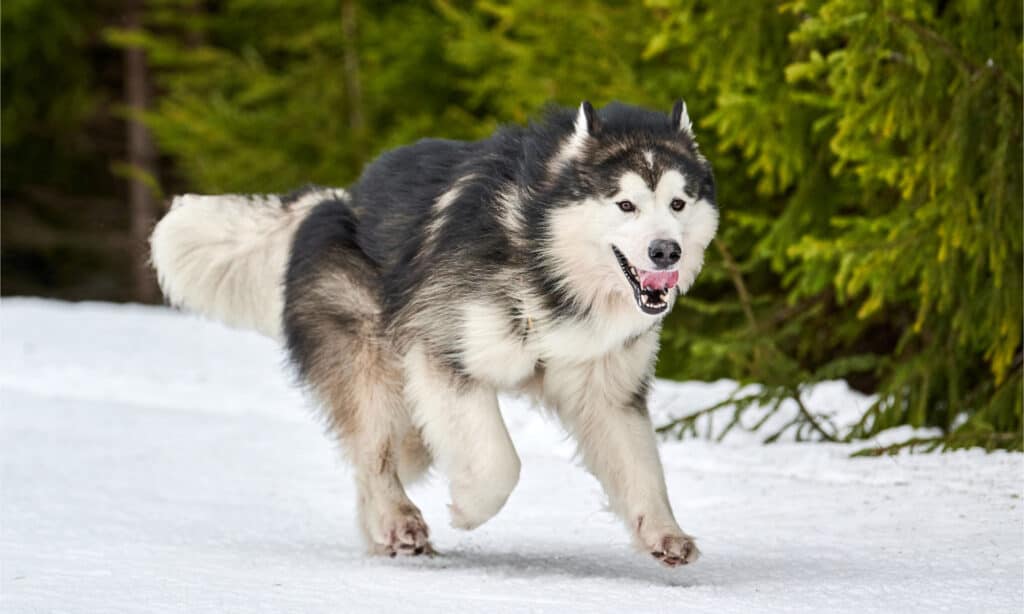
Alaskan Malamutes are an energetic breed that requires regular exercise to stay happy and healthy.
©travelarium.ph/Shutterstock.com
This is a large, powerful breed with a striking appearance, thick double coat, and exceptional strength. Originally bred as a sled dog for harsh Arctic conditions, this breed has a rich history and has become a popular choice for active households seeking a loyal and hardworking companion.
Breed Origin
The Alaskan Malamute comes from Alaska, where the Mahlemut tribe bred it as a sled dog and an all-purpose working dog. The breed can handle the extreme cold and pull heavy sleds over long distances at a steady pace. In the early 20th century, Alaskan Malamutes worked in various polar expeditions. People recognized them for their endurance and strength.
Personality and Temperament
Alaskan Malamutes are friendly, outgoing, and independent. They’re intelligent and trainable but can also be stubborn and strong-willed at times. Early, consistent training and socialization are crucial for Alaskan Malamutes to become well-adjusted companions. They have a strong pack mentality and form strong bonds with their families, but they can be aloof with strangers.
Alaskan Malamutes are an energetic breed that requires regular exercise to stay happy and healthy. They will thrive in active households with plenty of space for them to run and play. Their natural athletic abilities and stamina make them awesome buddies for physical activities.
7.) Bernese Mountain Dog
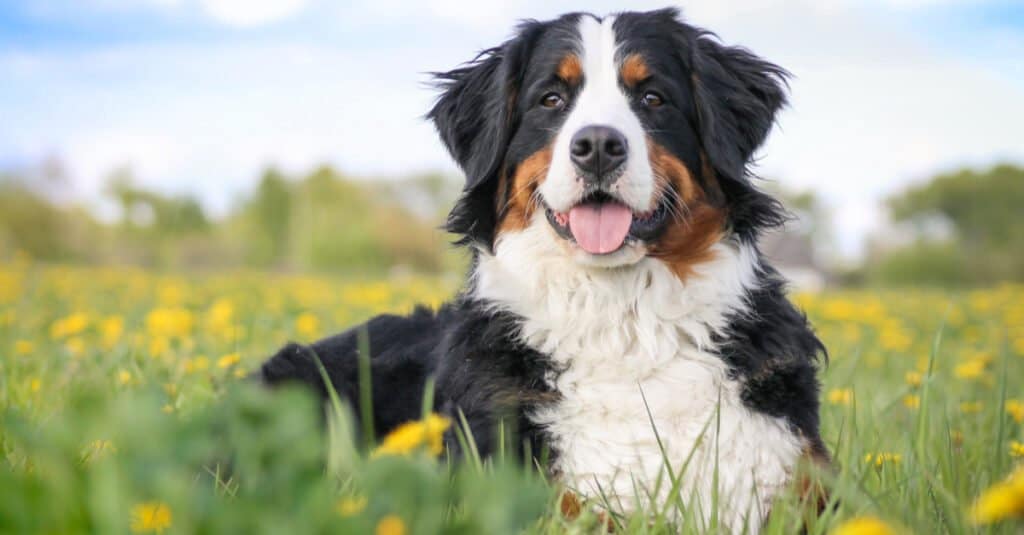
Bernese Mountain dogs form strong connections with their families and are particularly good with children.
©Eve Photography/Shutterstock.com
This is a large, gentle breed known for its striking tricolor coat, calm demeanor, and impressive strength. Originally bred as a working dog in the Swiss Alps, this breed has become a popular choice for families seeking a loyal, affectionate, and versatile companion.
Breed Origin
The Bernese Mountain dog originated in Switzerland, where it was bred as an all-purpose working dog. The breed’s ancestors were large, sturdy dogs brought to Switzerland by the Romans over 2,000 years ago. Bernese Mountain dogs worked to herd cattle, pull carts, and guard farms. Their thick, double coat allowed them to handle the cold, harsh weather conditions of the Swiss Alps.
Personality and Temperament
Bernese Mountain dogs are friendly, affectionate, and gentle. They’re intelligent and eager to please, which makes training fairly straightforward. They form strong connections with their families and are particularly good with children.
While Bernese Mountain dogs are generally calm and well-behaved indoors, they require regular exercise to maintain their health and happiness. They need to live in a household with adequate space to accommodate their large size and activity needs.
8.) Old English Sheepdog

English sheepdogs enjoy pleasing their owners and are a breeze to train.
The old English sheepdog is a large, charismatic breed known for its shaggy, abundant coat and charming, amiable personality. Originally bred as a herding dog in England, this breed has become a popular choice for families seeking a lovable, energetic, and intelligent pet.
Breed Origin
The old English sheepdog originated in England during the 18th century. Locals used them for herding sheep and cattle. The breed’s thick, weather-resistant double coat protected it from the cold and damp English climate, while its strength and agility made it an excellent herder. This dog’s ancestry isn’t known. But it may have developed from various European herding breeds.
Personality and Temperament
Old English sheepdogs are friendly, affectionate, and playful. They enjoy pleasing their owners and are a breeze to train. They form strong bonds and are particularly good with kids, often displaying a protective and nurturing instinct.
While old English sheepdogs are adaptable to various living situations, they require regular exercise to thrive. They must be able to run and play both inside and outside.
Key Takeaways
In this article, we have explored eight popular black and white dog breeds, each with a unique history, temperament, and care requirements.
When choosing a dog breed, consider your living situation, the breed’s activity level, and the time and resources you can dedicate to your new buddy. By understanding the specific needs and characteristics of each breed, you can make an informed decision and find the perfect black and white dog to welcome into your family.
Remember, responsible pet ownership involves regular vet care, proper training, and socialization, which will help ensure a happy and healthy life for your beloved four-legged friend.
The photo featured at the top of this post is © Mona / Creative Commons / Original
Ready to discover the top 10 cutest dog breeds in the entire world?
How about the fastest dogs, the largest dogs and those that are -- quite frankly -- just the kindest dogs on the planet? Each day, AZ Animals sends out lists just like this to our thousands of email subscribers. And the best part? It's FREE. Join today by entering your email below.
Thank you for reading! Have some feedback for us? Contact the AZ Animals editorial team.






